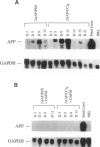Abstract
Administration of 2-acetylaminofluorene (2-AAF) given before a two-thirds partial hepatectomy (PHx), results in suppression of hepatocyte proliferation and stimulation of oval cell proliferation. Our objective in this study was to examine the oval cell response and associated alpha-fetoprotein (AFP) gene expression by combining 2-AAF with selective hepatic damage caused by either carbon tetrachloride (CCl4) exposure or by PHx. We also examined oval cell response with the above two protocols (2-AAF/CCl4 and 2-AAF/PHx) as affected by previous bile ductular damage caused by 4,4'-methylene dianiline (4,4'-diaminodiphenylmethane, DAPM) exposure. DAPM is an aromatic diamine, known to cause bile ductular damage in both humans and animals. Using the protocols of 2-AAF/ CCl4 and 2-AAF/PHx, when DAPM was given 24 hours before the hepatic injury, no oval cell proliferation was seen (histological) and AFP expression was not detected by Northern blot analysis. These results provide direct evidence that oval cells are closely associated with the biliary epithelial cells and supports the theory that hepatic oval cells may originate from cells derived from either intraportal or periportal ductules.
Full text
PDF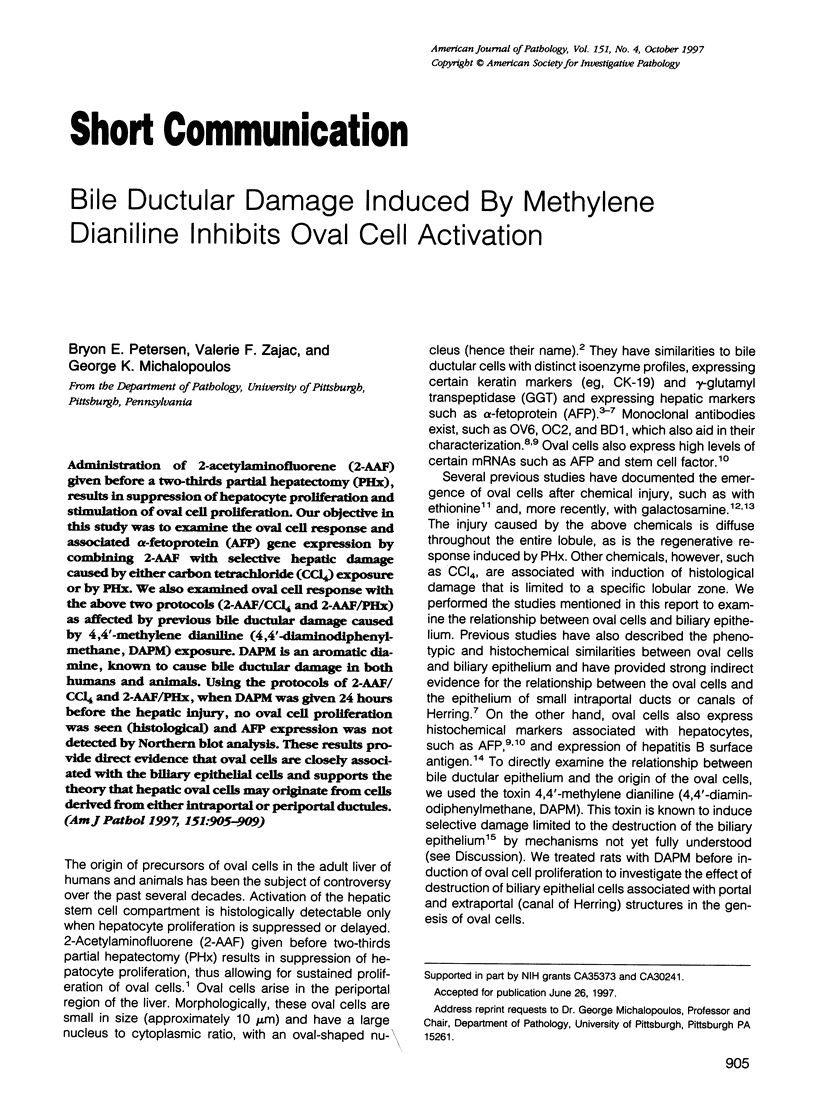
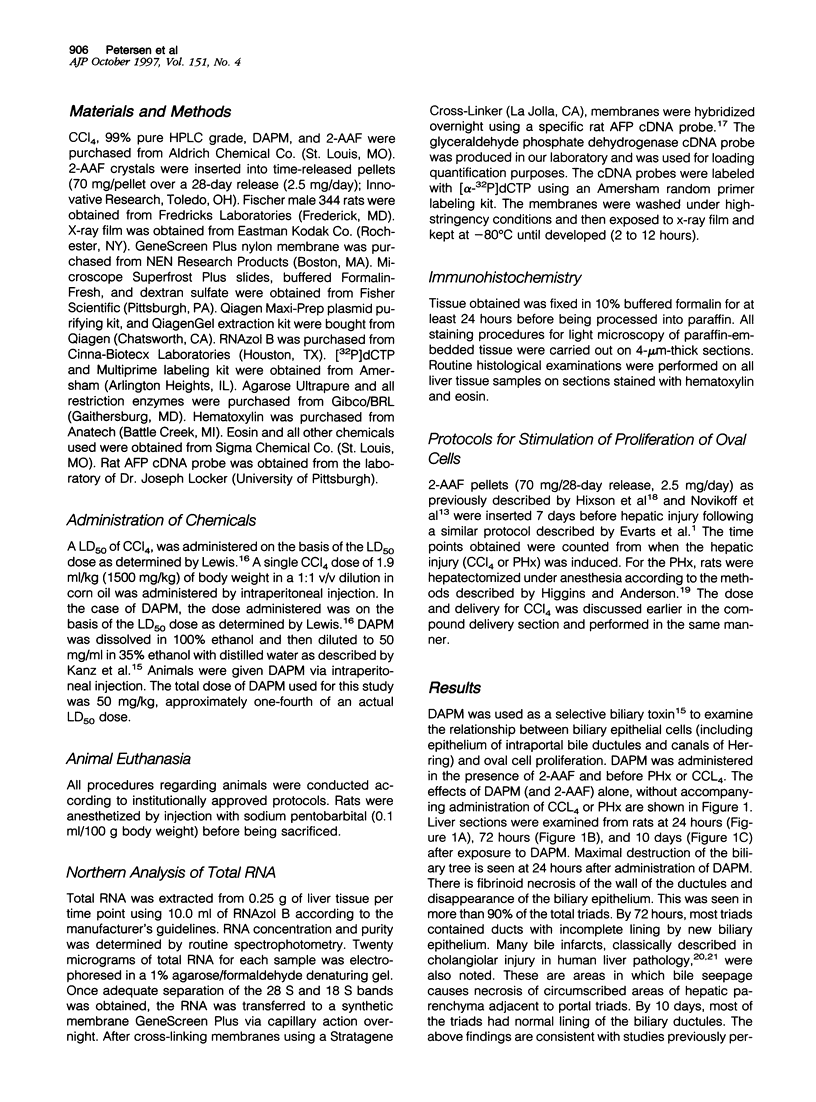
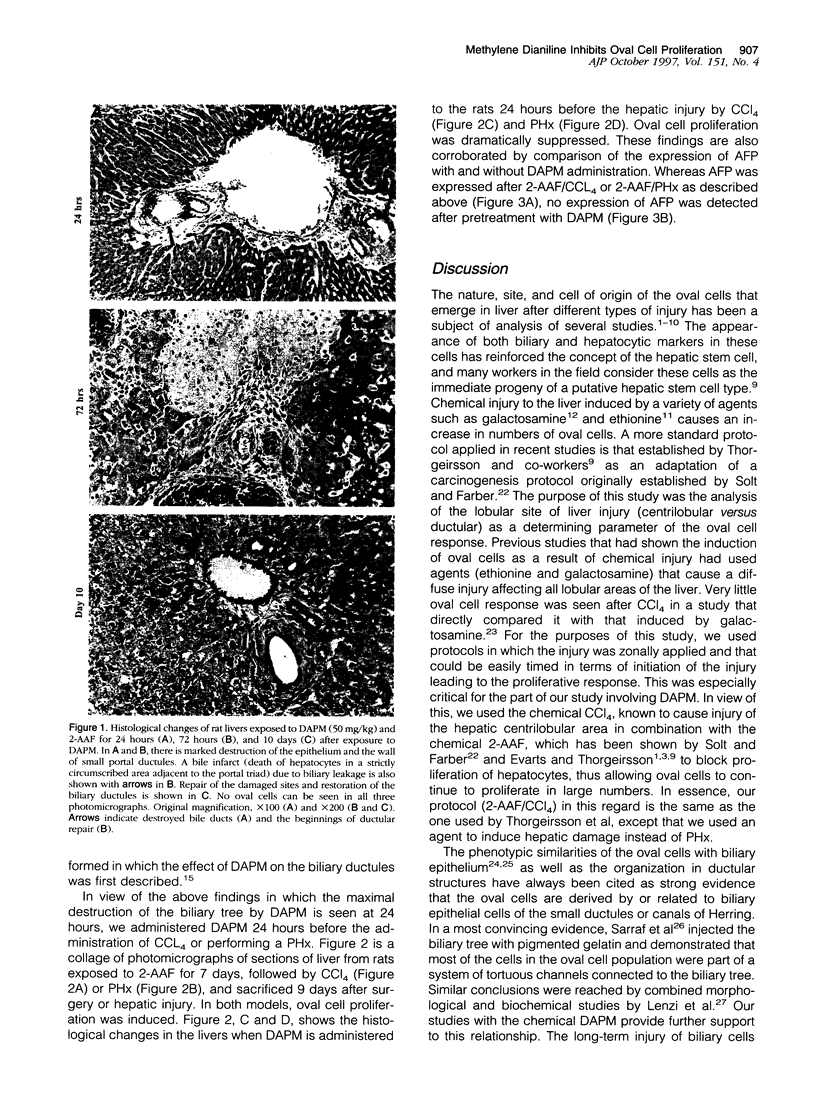

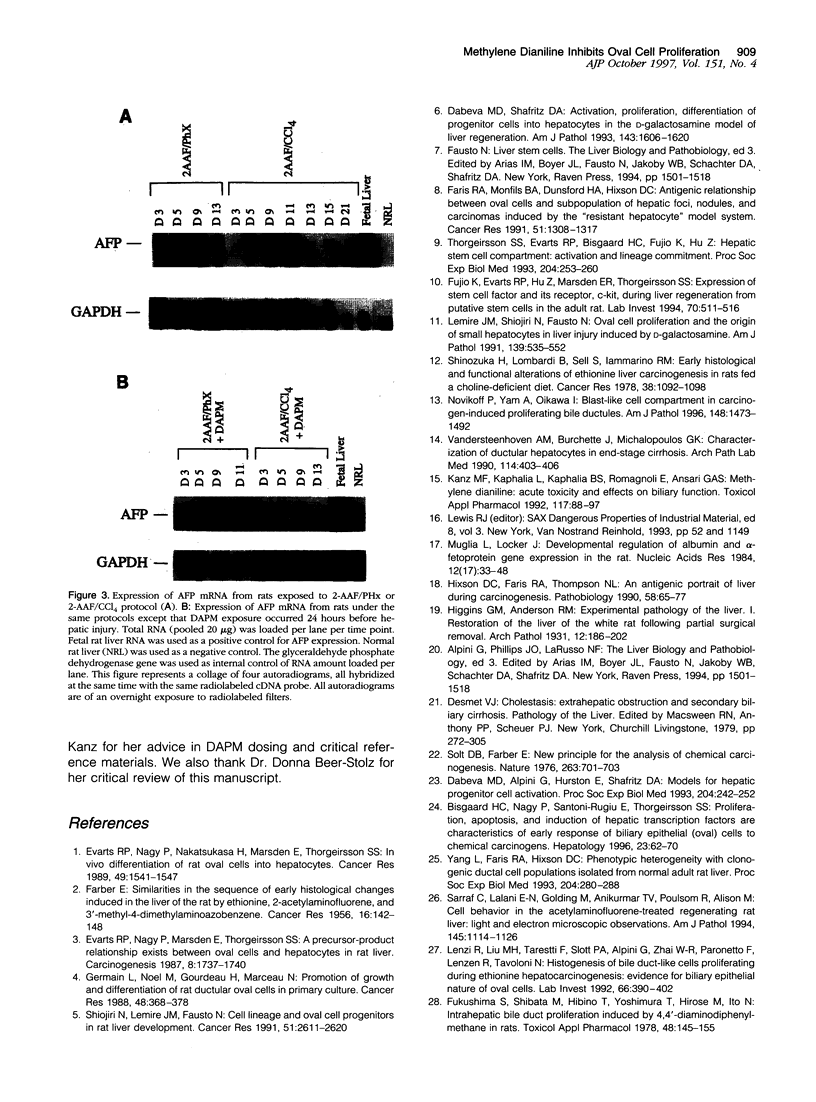
Images in this article
Selected References
These references are in PubMed. This may not be the complete list of references from this article.
- Bisgaard H. C., Nagy P., Santoni-Rugiu E., Thorgeirsson S. S. Proliferation, apoptosis, and induction of hepatic transcription factors are characteristics of the early response of biliary epithelial (oval) cells to chemical carcinogens. Hepatology. 1996 Jan;23(1):62–70. doi: 10.1002/hep.510230110. [DOI] [PubMed] [Google Scholar]
- Dabeva M. D., Alpini G., Hurston E., Shafritz D. A. Models for hepatic progenitor cell activation. Proc Soc Exp Biol Med. 1993 Dec;204(3):242–252. doi: 10.3181/00379727-204-43660. [DOI] [PubMed] [Google Scholar]
- Dabeva M. D., Shafritz D. A. Activation, proliferation, and differentiation of progenitor cells into hepatocytes in the D-galactosamine model of liver regeneration. Am J Pathol. 1993 Dec;143(6):1606–1620. [PMC free article] [PubMed] [Google Scholar]
- Evarts R. P., Nagy P., Marsden E., Thorgeirsson S. S. A precursor-product relationship exists between oval cells and hepatocytes in rat liver. Carcinogenesis. 1987 Nov;8(11):1737–1740. doi: 10.1093/carcin/8.11.1737. [DOI] [PubMed] [Google Scholar]
- Evarts R. P., Nagy P., Nakatsukasa H., Marsden E., Thorgeirsson S. S. In vivo differentiation of rat liver oval cells into hepatocytes. Cancer Res. 1989 Mar 15;49(6):1541–1547. [PubMed] [Google Scholar]
- FARBER E. Similarities in the sequence of early histological changes induced in the liver of the rat by ethionine, 2-acetylamino-fluorene, and 3'-methyl-4-dimethylaminoazobenzene. Cancer Res. 1956 Feb;16(2):142–148. [PubMed] [Google Scholar]
- Faris R. A., Monfils B. A., Dunsford H. A., Hixson D. C. Antigenic relationship between oval cells and a subpopulation of hepatic foci, nodules, and carcinomas induced by the "resistant hepatocyte" model system. Cancer Res. 1991 Feb 15;51(4):1308–1317. [PubMed] [Google Scholar]
- Fujio K., Evarts R. P., Hu Z., Marsden E. R., Thorgeirsson S. S. Expression of stem cell factor and its receptor, c-kit, during liver regeneration from putative stem cells in adult rat. Lab Invest. 1994 Apr;70(4):511–516. [PubMed] [Google Scholar]
- Fukushima S., Shibata M., Hibino T., Yoshimura T., Hirose M., Ito N. Intrahepatic bile duct proliferation induced by 4,4'-diaminodiphenylmethane in rats. Toxicol Appl Pharmacol. 1979 Mar 30;48(1 Pt 1):145–155. doi: 10.1016/s0041-008x(79)80017-4. [DOI] [PubMed] [Google Scholar]
- Germain L., Noël M., Gourdeau H., Marceau N. Promotion of growth and differentiation of rat ductular oval cells in primary culture. Cancer Res. 1988 Jan 15;48(2):368–378. [PubMed] [Google Scholar]
- Hixson D. C., Faris R. A., Thompson N. L. An antigenic portrait of the liver during carcinogenesis. Pathobiology. 1990;58(2):65–77. doi: 10.1159/000163565. [DOI] [PubMed] [Google Scholar]
- Kanz M. F., Kaphalia L., Kaphalia B. S., Romagnoli E., Ansari G. A. Methylene dianiline: acute toxicity and effects on biliary function. Toxicol Appl Pharmacol. 1992 Nov;117(1):88–97. doi: 10.1016/0041-008x(92)90221-d. [DOI] [PubMed] [Google Scholar]
- Lemire J. M., Shiojiri N., Fausto N. Oval cell proliferation and the origin of small hepatocytes in liver injury induced by D-galactosamine. Am J Pathol. 1991 Sep;139(3):535–552. [PMC free article] [PubMed] [Google Scholar]
- Lenzi R., Liu M. H., Tarsetti F., Slott P. A., Alpini G., Zhai W. R., Paronetto F., Lenzen R., Tavoloni N. Histogenesis of bile duct-like cells proliferating during ethionine hepatocarcinogenesis. Evidence for a biliary epithelial nature of oval cells. Lab Invest. 1992 Mar;66(3):390–402. [PubMed] [Google Scholar]
- Novikoff P. M., Yam A., Oikawa I. Blast-like cell compartment in carcinogen-induced proliferating bile ductules. Am J Pathol. 1996 May;148(5):1473–1492. [PMC free article] [PubMed] [Google Scholar]
- Sarraf C., Lalani E. N., Golding M., Anilkumar T. V., Poulsom R., Alison M. Cell behavior in the acetylaminofluorene-treated regenerating rat liver. Light and electron microscopic observations. Am J Pathol. 1994 Nov;145(5):1114–1126. [PMC free article] [PubMed] [Google Scholar]
- Shinozuka H., Lombardi B., Sell S., Iammarino R. M. Early histological and functional alterations of ethionine liver carcinogenesis in rats fed a choline-deficient diet. Cancer Res. 1978 Apr;38(4):1092–1098. [PubMed] [Google Scholar]
- Thorgeirsson S. S., Evarts R. P., Bisgaard H. C., Fujio K., Hu Z. Hepatic stem cell compartment: activation and lineage commitment. Proc Soc Exp Biol Med. 1993 Dec;204(3):253–260. doi: 10.3181/00379727-204-43661. [DOI] [PubMed] [Google Scholar]
- Vandersteenhoven A. M., Burchette J., Michalopoulos G. Characterization of ductular hepatocytes in end-stage cirrhosis. Arch Pathol Lab Med. 1990 Apr;114(4):403–406. [PubMed] [Google Scholar]
- Yang L., Faris R. A., Hixson D. C. Phenotypic heterogeneity within clonogenic ductal cell populations isolated from normal adult rat liver. Proc Soc Exp Biol Med. 1993 Dec;204(3):280–288. doi: 10.3181/00379727-204-43664. [DOI] [PubMed] [Google Scholar]





